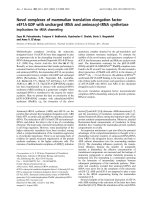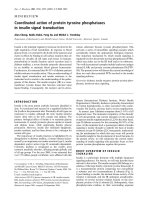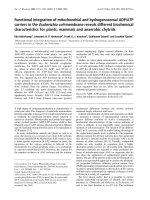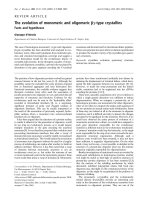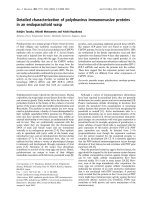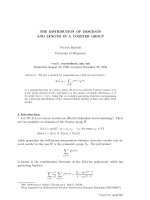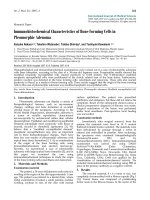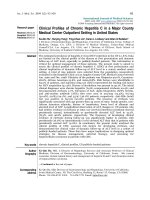Báo cáo y học: "Long-term tracking of neurological complications of encephalopathy and myopathy in a patient with nephropathic cystinosis: a case report and review of the literature" ppt
Bạn đang xem bản rút gọn của tài liệu. Xem và tải ngay bản đầy đủ của tài liệu tại đây (482.86 KB, 5 trang )
BioMed Central
Page 1 of 5
(page number not for citation purposes)
Journal of Medical Case Reports
Open Access
Case report
Long-term tracking of neurological complications of
encephalopathy and myopathy in a patient with nephropathic
cystinosis: a case report and review of the literature
Marcus Müller*, Andrea Baumeier, EB Ringelstein and IW Husstedt
Address: Department of Neurology, Universitätsklinikum Münster, Albert-Schweitzer-Strasse, D-48129 Münster, Germany
Email: Marcus Müller* - ; Andrea Baumeier - ; EB Ringelstein - ;
IW Husstedt -
* Corresponding author
Abstract
Introduction: Cystinosis is a hereditary storage disease resulting in intracellular accumulation of
cystine and crystal formation that causes deterioration of the function of many organs. The major
clinical symptom is renal failure, which progresses and necessitates renal transplantation at the
beginning of the second decade of life. Encephalopathy and distal myopathy are important
neurological long-term complications with a major impact on the quality of life of these patients.
Application of cysteamine is the only specific therapy available; it decreases the intracellular cystine
level and delays or may even prevent the failure of organ functions.
Case presentation: We present the case of a 38-year-old woman with cystinosis and the long-
term tracking of her neurological symptoms under cysteamine treatment.
Conclusion: This case report describes a long observation period of neurological complications
in a person with cystinosis who had strikingly different courses of encephalopathy and myopathy
while on cysteamine treatment. Although encephalopathy was initially suspected, this did not
develop, but distal myopathy progressed continuously despite specific therapy.
Introduction
Nephropathic cystinosis is a rare, autosomal recessive dis-
ease, based on a defect of the carrier-mediated transport of
cystine across the lysosomal membrane. As a consequence
cystine accumulates and forms crystals in most tissues,
which causes deterioration of organ function to different
degrees [1].
The disease manifests with developmental retardation,
polyuria, proteinuria and glucosuria. Without specific
treatment a renal tubular Fanconi syndrome and conse-
quently terminal renal failure occur. Since the life expect-
ancy of patients with cystinosis has increased in recent
times because of the availability of renal transplantation
and a specific therapy, complications of other organ dys-
functions can develop.
From a neurological perspective, important long-term
complications of nephropathic cystinosis are encephalop-
athy and distal myopathy.
In 1987 Jonas et al. described for the first time cystine
accumulation in the brain of a patient with cystinosis who
suffered from confusion and memory loss. Cranial com-
Published: 18 July 2008
Journal of Medical Case Reports 2008, 2:235 doi:10.1186/1752-1947-2-235
Received: 2 August 2007
Accepted: 18 July 2008
This article is available from: />© 2008 Müller et al; licensee BioMed Central Ltd.
This is an Open Access article distributed under the terms of the Creative Commons Attribution License ( />),
which permits unrestricted use, distribution, and reproduction in any medium, provided the original work is properly cited.
Journal of Medical Case Reports 2008, 2:235 />Page 2 of 5
(page number not for citation purposes)
puted tomography (CCT) confirmed cerebral atrophy [2].
Subsequently, neurological symptoms such as mental
retardation, epileptic seizures, tremor and pyramidal syn-
dromes were observed in patients with cystinosis [3,4].
In parallel, cystine accumulation was detected in muscular
tissue and in 1988 the first case of severe myopathy was
reported [5]. A 20-year-old patient with cystinosis was
described, suffering from progressing dysphagia and
weakness of the hands and arms. Subsequently the patient
lost the ability to sit up without assistance and could walk
only three blocks without resting. Post-mortem muscle
studies revealed peri- and endomysial cystine crystals.
Shortly afterwards, an in vitro study confirmed cystine
accumulation in myotube cells [6] from patients with
cystinosis.
A study of 54 post-transplant patients with cystinosis
found distal myopathy in 13 of these patients [7]. Clinical
signs consisted of weakness and atrophy of the small mus-
cles of the hand, dysphagia and facial weakness. Nerve
conduction studies revealed no abnormalities. Dysphagia
and swallowing dysfunction were evaluated in a separate
study by Sonies et al. [8], who demonstrated age-depend-
ent dysphagia in nearly all patients with cystinosis. In
addition Vester et al. demonstrated electrophysiological
signs of myopathy in patients with cystinosis without
obvious weakness [9]. Myopathic changes were most
prominent in the small muscles of the hand.
The only specific therapy for cystinosis is the oral applica-
tion of cysteamine (cysteamine bitartrate, Cystagon
®
),
which transforms cystine into a soluble form that may
leave the cell [10]. A beneficial effect for cystinosis-associ-
ated encephalopathy is described. Whether or not
cysteamine therapy influences cystinosis-associated
myopathy [3] is uncertain, however a positive effect on
dysphagia as a myopathic symptom has been suggested
[11].
Case presentation
We report the clinical course of a 38-year-old woman,
who had been entirely normal at birth, but by the age of 6
months had developed polydipsia, polyuria and vomit-
ing, which led to the diagnosis of nephropathic cystinosis.
By the age of 13 years, the patient suffered from terminal
renal insufficiency and finally required dialysis. One year
later she underwent renal transplantation.
At the age of 23 years, the patient noticed a lack of concen-
tration and motor coordination. She underwent neuro-
logical examination by a neuropediatrician experienced
with cystinosis-associated symptoms. No clinical or neu-
rophysiological disturbances were identified; in particu-
lar, no clinical signs of cerebellar dysfunction, dysmetria
in point-to-point movements, dysdiadochokinesis, ataxia
or dysarthria were detectable.
Two years later, due to symptom persistence, the patient
had a second neurological examination. Asymmetric ten-
don reflexes, slightly dysmetric point-to-point move-
ments and a minimal dysdiadochokinesis pointing
towards minor cerebellar dysfunction were observed at
that point. Electrophysiology revealed a pathological
P300 potential. Signs of myopathy were not observed. An
initial magnetic resonance tomography (MRT) scan
revealed cerebral atrophy (Figure 1A).
By the age of 29 years, intermittent episodes of somno-
lence were reported and the patient was admitted to the
neurology ward. A CCT scan revealed generalised cortical
atrophy. Physical examination demonstrated asymmetric
tendon reflexes and no signs of myopathy but there was
dysdiadochokinesis, dysmetric point-to-point move-
ments and a gait imbalance when walking in a straight
line. At this point specific therapy with Cystagon
®
was
Imaging studiesFigure 1
Imaging studies. (A) Initial magnetic resonance imaging
revealed signs of cerebral atrophy with a prominent inter-
hemispheral fissure at the age of 23 years. (B) The second
magnetic resonance imaging 11 years later did not reveal any
progression of cerebral atrophy nor any other signs of cysti-
nosis-associated encephalopathy. (C) Positron emission tom-
ography at the age of 34 years demonstrated normal cortical
glucose utilisation without signs of encephalopathy.
Journal of Medical Case Reports 2008, 2:235 />Page 3 of 5
(page number not for citation purposes)
commenced (30 mg/kg, three daily doses with the highest
dosage in the evening) and the effect of the therapy was
controlled by determining the lymphocyte cysteine levels
(between 0.2 and 0.47 nmol/mg protein). Higher dosages
were not tolerated by the patient.
By the age of 32 years, myopathic signs were observed
despite effective cysteamine therapy, and cystinosis-asso-
ciated distal myopathy was diagnosed by clinical criteria.
During the following 2 years, the patient suffered from
recurrent depressive episodes according to ICD-10
(F33.2). Due to additional difficulties in concentration
progressive cystinosis-associated encephalopathy was sus-
pected and the patient was again admitted to the neurol-
ogy ward.
She was admitted at the age of 34 years and reported dif-
fuse complaints such as holocephalic headache, general-
ised weakness and difficulties in swallowing. She stated
that for the last 3 months she had spent most of the day-
time in bed and had felt very listless. The neurological
examination after admission revealed no clinical signs of
encephalopathy. Major cognitive or amnestic deficits were
not observable. Tendon reflexes were symmetrical and
pathologic pyramidal signs were not present. Further-
more, the clinical examination did not reveal any signs of
the cerebellar dysfunction that had been documented 5
years earlier. Strength testing demonstrated symmetrical
distal paresis of the arms and legs which was most pro-
nounced in the hands and feet. Small muscles of the feet
and hands were atrophic. The mini mental state examina-
tion (MMSE) was normal.
In contrast to the suspected cystinosis-associated enceph-
alopathy, the patient's interview again revealed signs of a
recurrent depressive episode. She reported depressed
mood, anhedonia, loss of interest and enjoyment, and
reduced energy, combined with low self-esteem and a
sense of worthlessness and despair. To examine the
impairment of other organ functions by the cystinosis, an
extensive set of laboratory tests was performed. Glucose
and HbA1C testing ruled out diabetes mellitus but an oral
glucose tolerance test (OGTT) confirmed impaired glu-
cose tolerance. Thyroid-stimulating hormone (TSH) level
was normal under treatment with 100 μg L-thyroxin,
which had been commenced because of cystinosis-associ-
ated hypothyroidism. Examination of the eyes revealed
opacity of the corneas and decreased vision despite the
regular use of cysteamine eyedrops.
To exclude cystinosis-associated encephalopathy, diag-
nostic procedures were performed including a second
MRT (Figure 1B), electroencephalography (EEG), a [18F]-
2-fluoro-deoxy-D-glucose positron emission tomography
(FDG-PET, Figure 1C) and a neuropsychological examina-
tion. The MRT scan revealed brain atrophy but compared
with the previous scan showed no progression. EEG was
normal and the FDG-PET results showed normal brain
metabolism without any further focal or general meta-
bolic disturbances. Extensive neuropsychological testing
revealed distractibility, poor concentration and memory
impairments consistent with a depressive episode. Higher
cortical functions were intact.
Concerning the clinical suspicion of cystinosis-associated
myopathy, electromyography (EMG) and nerve conduc-
tion studies revealed a typical myopathic EMG pattern
with spontaneous activity in all muscles examined. Mus-
cle potentials were shortened with low amplitude. Motor-
unit recruitment was abnormally early. Myopathic
changes were most pronounced in the small musculature
of the hands. Nerve conduction studies were normal. The
patient refused further evaluation by muscle biopsy.
A depressive episode was diagnosed by an experienced
psychiatrist according to ICD-10 (F33.2) criteria and anti-
depressive therapy with a selective serotonin re-uptake
inhibitor (SSRI) was started. The diagnosis of cystinosis-
associated myopathy was confirmed and cystinosis-asso-
ciated encephalopathy ruled out.
After discharge from hospital, the patient was regularly
examined in the outpatient clinic. One year after admis-
sion, no clinical signs of progressive encephalopathy and
no symptoms of recurring depression were observed. She
reported vitality and days spent in planning and enjoying
activities, although muscle wasting progressed. In the
meantime, corneal transplantations were successfully per-
formed and resulted in a dramatic improvement in vision.
She reported that motor functions involved in, for exam-
ple, cutting up meat or climbing stairs were increasingly
difficult. EMG confirmed progress of the myopathy with
increased spontaneous activity and short and polyphasic
motor unit potentials, mainly in distal arm muscles.
Acoustic and somatosensory evoked potentials and EEG
were normal. The neuropsychological examination was
repeated and in parallel with improvement of depressive
symptoms the previous cognitive deficits were improved.
Higher cortical functions were again unimpaired.
One year later, at the age of 38 years, the patient was
examined again and no major changes of cognitive func-
tions and mood were observed. Compared with the previ-
ous examination, the myopathy had progressed and the
patient now reported that, in addition to the previously
reported motor symptoms, writing and chewing were
more difficult. The cysteamine therapy was continued
without disruption.
Journal of Medical Case Reports 2008, 2:235 />Page 4 of 5
(page number not for citation purposes)
Discussion
Encephalopathy and myopathy are long-term complica-
tions of nephropathic cystinosis. These complications are
become increasingly apparent because the lifespan of
patients with cystinosis is increasing. As a result of renal
transplantation and the availability of cysteamine,
patients with cystinosis who are older than 20 years are no
longer uncommon and the number of adults with cystino-
sis will increase in the future.
Cystinosis-associated encephalopathy was first described
in 1982 in a 19-year-old patient with cystinosis who had
hemiparesis and dysarthria [12]. In the following years
many studies reported symptoms of encephalopathy in
patients with cystinosis and confirmed this first observa-
tion. It was estimated that 50% of all untreated patients
with cystinosis have signs of encephalopathy [4]. A fol-
low-up study of treated patients found a lower incidence
of neurological complications [13].
Cystinosis-associated encephalopathy may occur with dif-
ferent manifestations. Cerebral atrophy was observed in
several studies and although terminal renal insufficiency
could also lead to cerebral atrophy, the frequency and
severity of brain atrophy in untreated patients with cysti-
nosis is higher than in patients with terminal renal insuf-
ficiency alone. In addition, hydrocephalus
malresorptivus, focal demyelinated lesions and cystic
necrosis were observed. Some patients suffer from recur-
rent phases of somnolence, epileptic seizures, pyramidal
tract lesions and mental retardation. Broyer et al. [4] ana-
lysed a series of cases and found that patients with cysti-
nosis who are older than 23 years have an increasing risk
for cystinosis-associated encephalopathy. Half of the
patients had clinical signs of encephalopathy. In addition
it was demonstrated that subsequent therapy with
cysteamine could stop the progression of encephalopathy
and in some cases could improve other neurological defi-
cits [4].
Muscular tissue accumulates cystine as well and the first
case of cystinosis-associated myopathy was described in
1988 [5]. Clinically, patients develop a distally pro-
nounced atrophic myopathy with difficulties in swallow-
ing, which is a pattern comparable to other myopathies
such as inclusion body myositis. In our patient cystinosis-
associated myopathy was first diagnosed in 1997. The
myopathy must have developed between 1994 and 1997
because the neurological examination in 1994 revealed
no obvious signs of myopathy. In 2000, muscular weak-
ness and distal atrophies were the distinct pathologic fea-
tures and progressed continuously despite cysteamine
therapy over the following years.
Cysteamine is the only effective therapy for cystinosis. It
has been available since 1976 [14,15] and was approved
for the therapy of cystinosis in 1994. Cysteamine trans-
forms intralysosomal cystine to cysteine, which is able to
leave the cell independently of the defective cystine trans-
porter. Measuring the cystine level of lymphocytes or
fibroblasts can monitor the therapeutic effect. With early
and subsequent cysteamine therapy renal function can be
preserved. In addition, a beneficial effect on cystinosis-
associated encephalopathy is described [4], whereas the
effect of cysteamine on cystinosis-associated myopathy
has not yet been proved, although the beneficial effect on
dysphagia suggests such an effect.
A beneficial effect of the therapy can also be assumed in
the case reported here. At the age of 25 years, before the
initiation of cysteamine therapy, the patient had signs of
cerebral atrophy confirmed by an MRT scan. Cerebral
atrophy in a patient with cystinosis points towards a
developing encephalopathy. In contrast, with specific
cysteamine treatment no progression of brain atrophy
could be observed in the following years. The MRT scan
carried out 11 years after the first examination revealed
unaltered cerebral atrophy without further structural
abnormalities. In addition, no clinical signs of cystinosis-
associated encephalopathy were observed at that time.
Considering that the study by Broyer et al. demonstrated
that the percentage of encephalopathy-free patients with
cystinosis according to age declines from 95% at the age
of 23 years to 55% at the age of 27 years, the course of this
patient, who is now 39 years old and without signs of
encephalopathy, is remarkable.
In contrast, cystinosis-associated myopathy, diagnosed in
1997, became clinically obvious during cysteamine ther-
apy and progressed despite this therapy. Intracellular cys-
tine was regularly determined in lymphocytes and proved
the efficacy of the therapy. Myopathic changes were
mostly prominent in distal limb muscles and led to
restrictions in motor function of the hands, which is the
typical course of cystinosis-associated myopathy.
Although no study has yet addressed the question of
whether cysteamine is an effective treatment for cystino-
sis-associated myopathy, Gahl et al. demonstrated that
cysteamine is able to deplete muscular tissue of cystine. In
our patient, the myopathy progressed, pointing towards
an insufficient effect of the cysteamine therapy to prevent
or stop progression of the cystinosis-associated myopathy.
Several reasons could explain this observation: one could
speculate that muscular tissue is more susceptible to intra-
cellular cystine accumulation and a cystine concentration
that will not affect non-muscular tissue could be harmful
to muscular tissue. Considering the anatomical structure
Publish with BioMed Central and every
scientist can read your work free of charge
"BioMed Central will be the most significant development for
disseminating the results of biomedical research in our lifetime."
Sir Paul Nurse, Cancer Research UK
Your research papers will be:
available free of charge to the entire biomedical community
peer reviewed and published immediately upon acceptance
cited in PubMed and archived on PubMed Central
yours — you keep the copyright
Submit your manuscript here:
/>BioMedcentral
Journal of Medical Case Reports 2008, 2:235 />Page 5 of 5
(page number not for citation purposes)
and the mechanical stress which muscular tissue under-
goes, it is conceivable that muscular tissue might be more
susceptible to cystine-mediated damage. Referring to the
distribution pattern of the myopathy, one could speculate
that the cystine load of different muscles and the associ-
ated muscle damage are also variable and normal cystine
levels in some muscles may not exclude high levels in oth-
ers. Another explanation could be that the effect of
cysteamine is variable in different types of muscle.
Although the above explanations are speculative, this case
report highlights the important need for a better under-
standing of the pathogenesis of the different cystinosis
complications, which can have different dynamics.
Conclusion
In conclusion, we have presented and discussed the case a
38-year-old patient with cystinosis. The course of long-
term neurological complications of encephalopathy and
myopathy were observed over a period of more than 15
years. Effective cysteamine therapy could not prevent the
progression of cystinosis-associated myopathy, whereas
early signs of developing encephalopathy did not progress
over almost 15 years. This case report demonstrates the
possible divergent course of cystinosis-induced neurolog-
ical complications and the need for new therapeutic
options.
As the lifespan of patients with cystinosis has increased
over the last decades, the neurological complications of
this disease will increasingly challenge their physicians.
Abbreviations
CCT, cranial computed tomography; EEG, electroen-
cephalography; EMG, electromyography; FDG-PET,
[18F]-2-fluoro-deoxy-D-glucose positron emission tom-
ography; MRT, magnetic resonance tomography; OGTT,
oral glucose tolerance test; SSRI, selective serotonin re-
uptake inhibitor; TSH, thyroid-stimulating hormone.
Competing interests
The authors declare that they have no competing interests.
Consent
Written informed consent was obtained from the patient
for publication of this case report and any accompanying
images. A copy of the written consent is available for
review by the Editor-in-Chief of this journal.
Authors' contributions
MM examined the patient, reviewed the literature, wrote
the manuscript and prepared the Figure. AB examined the
patient and prepared the patient's history. ER and IH crit-
ically reviewed the manuscript and contributed to the dis-
cussion.
References
1. Gahl WA: Nephropathic cystinosis. Pediatr Rev 1997, 18:302-304.
2. Jonas AJ, Conley SB, Marshall R, Johnson RA, Marks M, Rosenberg H:
Nephropathic cystinosis with central nervous system
involvement. Am J Med 1987, 83:966-970.
3. Fink JK, Brouwers P, Barton N, Malekzadeh MH, Sato S, Hill S, Cohen
WE, Fivush B, Gahl WA: Neurologic complications in long-
standing nephropathic cystinosis. Arch Neurol 1989, 46:543-548.
4. Broyer M, Tete MJ, Guest G, Bertheleme JP, Labrousse F, Poisson M:
Clinical polymorphism of cystinosis encephalopathy. Results
of treatment with cysteamine. J Inherit Metab Dis 1996, 19:65-75.
5. Gahl WA, Dalakas MC, Charnas L, Chen KT, Pezeshkpour GH,
Kuwabara T, Davis SL, Chesney RW, Fink J, Hutchison HT: Myopa-
thy and cystine storage in muscles in a patient with nephro-
pathic cystinosis. N Engl J Med 1988, 319:1461-1464.
6. Harper GS, Bernardini I, Hurko O, Zuurveld J, Gahl WA: Cystine
storage in cultured myotubes from patients with nephro-
pathic cystinosis. Biochem J 1987, 243:841-845.
7. Charnas LR, Luciano CA, Dalakas M, Gilliatt RW, Bernardini I, Ishak
K, Cwik VA, Fraker D, Brushart TA, Gahl WA: Distal vacuolar
myopathy in nephropathic cystinosis. Ann Neurol 1994,
35:181-188.
8. Sonies BC, Ekman EF, Andersson HC, Adamson MD, Kaler SG, Mar-
kello TC, Gahl WA: Swallowing dysfunction in nephropathic
cystinosis. N Engl J Med 1990, 323:565-570.
9. Vester U, Schubert M, Offner G, Brodehl J: Distal myopathy in
nephropathic cystinosis. Pediatr Nephrol 2000, 14:36-38.
10. Gahl WA: Early oral cysteamine therapy for nephropathic
cystinosis. Eur J Pediatr 2003, 162(Suppl 1):S38-41.
11. Sonies BC, Almajid P, Kleta R, Bernardini I, Gahl WA: Swallowing
dysfunction in 101 patients with nephropathic cystinosis:
benefit of long-term cysteamine therapy. Medicine 2005,
84:137-146.
12. Levine S, Paparo G: Brain lesions in a case of cystinosis. Acta
Neuropathol 1982, 57:217-220.
13. Geelen JM, Monnens LA, Levtchenko EN: Follow-up and treat-
ment of adults with cystinosis in the Netherlands. Nephrol Dial
Transplant 2002, 17:1766-1770.
14. Thoene JG, Oshima RG, Crawhall JC, Olson DL, Schneider JA: Cysti-
nosis. Intracellular cystine depletion by aminothiols in vitro
and in vivo. J Clin Invest 1976, 58:180-189.
15. Humphrey C: Cysteamine for cystinosis. Lancet 1978, 2:998.
